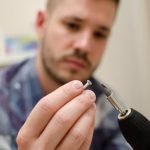Having a strong cell signal at home is essential for staying connected in today’s digital age. Poor cell signal can lead to dropped calls, slow data speeds, and frustration. According to recent statistics, a significant number of people face challenges with weak cell signal in their homes, impacting their ability to communicate effectively.
There are several reasons why you may be experiencing poor cell signal at home. Factors such as the distance from the nearest cell tower, building materials that block signals, and interference from household electronics can all contribute to this issue. Understanding the causes of weak signal is the first step towards finding effective solutions.
In this article, we will explore various strategies on how to improve your cell signal at home. From conducting a signal strength test to installing external antennas and signal boosters, we will provide you with practical tips and solutions to enhance your cell reception. By taking proactive steps to enhance your cell signal, you can enjoy seamless communication and connectivity within the comfort of your own home.
Causes of Poor Cell Signal at Home
Having a poor cell signal at home can be frustrating, especially in this digital age where connectivity is crucial. Understanding the causes of weak cell signal can help you find solutions to improve it. One common reason for poor cell signal at home is the distance from the nearest cell tower.
If you live in a remote area or on the outskirts of town, you may struggle with a weak signal. Building materials can also play a significant role in blocking cell signals. Materials like concrete, metal, and low-emissivity glass can hinder the penetration of cellular signals into your home.
Another factor that contributes to poor cell signal at home is interference from electronics. Devices such as microwaves, cordless phones, and even baby monitors can disrupt cellular signals, leading to dropped calls and slow data speeds. Identifying these causes can help you take the necessary steps to improve your cell signal at home.
To address the issue of poor cell signal at home, there are several steps you can take. First, consider conducting a signal strength test using tools like apps or websites that measure signal quality. By understanding your current signal strength, you can determine the best solutions to boost it. Installing external antennas or signal boosters is one effective way to enhance your cell signal at home. These devices amplify incoming and outgoing signals, providing better connectivity within your living space.
- Check your distance from the nearest cell tower.
- Identify building materials that may be blocking your cell signal.
- Avoid interference from household electronics.
In addition to using external antennas and boosters, Wi-Fi calling is another option to consider for improving your cell signal at home. By utilizing your Wi-Fi network to make calls or send texts, you can bypass cellular networks altogether and ensure a more stable connection. Setting up Wi-Fi calling on your device is usually straightforward and can significantly enhance your communication experience.
- Install external antennas or signal boosters.
- Consider using Wi-Fi calling for improved connectivity.
- Position your phone correctly for better reception.
Conduct a Signal Strength Test
Many people often wonder, “How to improve my cell signal at home?” One crucial step in finding a solution is to conduct a signal strength test. Checking the signal strength in different areas of your home can help pinpoint where you may need to focus on improving it.
There are various tools available to check your cell signal strength, such as apps like OpenSignal or CellMapper. These apps provide detailed information about the signal quality and strength in different locations within your home. Additionally, most smartphones also have a built-in feature that displays the current signal strength.
When interpreting the results of a signal strength test, keep an eye out for factors that may be affecting your cell signal. If you notice that certain areas have significantly weaker signals, consider potential causes such as the distance from the nearest cell tower, building materials that block signals like concrete or metal, or interference from other electronics in your home.
Identifying these issues will help you determine which solutions will be most effective in improving your cell signal at home.
By conducting a thorough signal strength test and understanding the factors influencing your cell signal quality, you can take targeted steps to enhance it. Whether it’s investing in external antennas and signal boosters, setting up Wi-Fi calling, or strategically positioning your phone for optimal reception, knowing where improvements are needed is the first step towards enjoying strong and reliable cell service at home.
External Antennas and Signal Boosters
Having a reliable cell signal at home is crucial for staying connected, especially in today’s digital age where most communication and work are done through mobile devices. Many individuals struggle with poor cell signal at home, leading to dropped calls, slow internet speeds, and overall frustration. One effective way to improve cell signal at home is by using external antennas and signal boosters.
How External Antennas Work
External antennas work by capturing the existing outdoor cell signal and amplifying it to provide better coverage indoors. These antennas are typically installed on the exterior of the building or in an area with good reception to ensure optimal performance. By boosting the signal strength, external antennas help improve call quality and data speeds within your home.
Different Types of Signal Boosters Available
There are several types of signal boosters available on the market, ranging from small plug-and-play units to more robust systems designed for larger homes or buildings. Some boosters are specific to certain carriers, while others work across multiple networks. It’s essential to choose a signal booster that suits your needs and addresses the specific challenges you face with poor cell signal at home.
Installation Tips for Optimal Performance
To maximize the effectiveness of external antennas and signal boosters, proper installation is key. Ensure that antennas are placed in an area with strong outdoor signal reception and follow manufacturer guidelines for placement and setup. Additionally, regularly check and adjust the antenna orientation if needed to maintain stable and improved cell signal throughout your home. With the right setup, external antennas and signal boosters can significantly enhance your cell phone experience at home.
Wi-Fi Calling
In today’s fast-paced world, a reliable cell signal at home is crucial for staying connected with friends, family, and colleagues. Poor cell signal not only leads to dropped calls or delayed messages but also hinders the use of data services on your mobile device. According to recent studies, more than 70% of smartphone users experience issues with their cell signal at home at some point, highlighting the importance of finding ways to improve connectivity.
One effective solution to enhance your cell signal at home is through Wi-Fi calling. This innovative feature allows you to make and receive calls over a Wi-Fi network instead of relying solely on the cellular network. By utilizing Wi-Fi calling, you can bypass weak cellular signals and ensure crystal-clear calls and fast data speeds right from the comfort of your home.
To set up Wi-Fi calling on your device, follow these simple steps:
- For iPhone users: Go to Settings > Phone > Wi-Fi Calling and toggle the switch to enable the feature.
- For Android users: Navigate to Settings > Network & Internet > Mobile Network > Advanced > Wi-Fi Calling and turn it on.
By enabling Wi-Fi calling on your smartphone, you can significantly improve your cell signal at home without investing in additional equipment or services. It’s a convenient and cost-effective way to stay connected even in areas with poor cellular coverage.
Positioning Your Phone Correctly
Having a strong cell signal at home is essential for staying connected with family, friends, and colleagues, as well as accessing important information and services. However, many people struggle with poor cell signal quality inside their homes, leading to dropped calls and slow data speeds.
According to recent statistics, over 70% of mobile users experience some form of signal issues at home. This can be frustrating, but there are steps you can take to improve your cell signal and enhance your overall connectivity.
One simple yet effective way to improve your cell signal at home is by correctly positioning your phone. The way you hold or place your phone can significantly impact the signal strength you receive. To get the best possible signal, try holding your phone upright or laying it flat on a surface rather than holding it horizontally. You may also want to experiment with different positions around your home to find the spot with the strongest signal.
In addition to proper positioning, avoiding signal dead zones in your home is crucial for maintaining a strong cell signal. Dead zones are areas where the signal is weak or completely absent, often due to interference from obstacles like walls or electronic devices.
By identifying and avoiding these dead zones, you can ensure that you’re always getting the best possible reception on your phone. If necessary, consider moving furniture or rearranging electronics to minimize these obstructions and improve your overall cell signal quality.
By following these tips on how to position your phone correctly and avoid signal dead zones at home, you can enhance your cell signal strength and enjoy seamless connectivity throughout your living space. Experiment with different positions for optimal reception, and be mindful of potential obstacles that could be interfering with your signal.
With these simple adjustments, you can significantly improve your cell signal quality at home and stay connected whenever you need to make a call or browse the web.
Network Extenders
Having a strong cell signal at home is crucial for staying connected, whether for work, leisure, or emergencies. Unfortunately, many people experience poor cell signal quality within their homes, leading to dropped calls and frustration.
According to recent statistics, about 72% of Americans have experienced some form of dropped calls or poor connectivity on their cell phones. If you are one of the many individuals wondering how to improve your cell signal at home, investing in network extenders could be the solution you need.
Network extenders are devices designed to boost your cell signal by amplifying it within your home. They work by capturing the existing weak signal from outside your house and rebroadcasting it with enhanced strength. When strategically placed, network extenders can significantly improve your cell signal quality and reduce issues like dropped calls and slow data speeds. With various options available on the market, choosing the right network extender for your specific needs is essential.
When selecting a network extender for your home, consider factors such as the size of your living space, the number of users relying on the boosted signal, and the compatibility with your carrier’s network. Some popular network extender brands include weBoost, SureCall, and HiBoost, each offering different features and capabilities.
To maximize the performance of your network extender, follow installation tips provided by the manufacturer and ensure that it is placed in an area where it can capture a reliable outside signal. By investing in a quality network extender, you can enjoy improved cell signal quality throughout your home.
| Benefits of Network Extenders | Tips for Choosing a Network Extender |
|---|---|
| Boosts cell signal strength | Consider size of living space |
| Reduces dropped calls | Check compatibility with carrier |
| Improves data speeds | Follow manufacturer’s installation tips |
Eliminate Obstacles
Poor cell signal at home can be frustrating and disruptive, especially in today’s world where staying connected is crucial. It is important to address this issue to ensure seamless communication and access to data. According to recent statistics, a significant number of individuals experience poor cell signal at home, highlighting the widespread nature of this problem. To improve your cell signal at home, there are various steps you can take to eliminate obstacles that are hindering a strong connection.
One common cause of poor cell signal at home is interference from household electronics. Devices such as cordless phones, microwaves, and even baby monitors can disrupt the signal strength, leading to dropped calls and slow internet speeds. To mitigate this interference, consider relocating these electronics or switching them off when not in use. Additionally, investing in shielded cables for your devices can help reduce electromagnetic interference that affects your cell signal.
Another obstacle to a strong cell signal at home is building materials that block signals. Materials like concrete, metal, and energy-efficient windows can impede the transmission of cellular signals within your home. To overcome this barrier, you may need to strategically position your phone or install a network extender to amplify the signal reach. By addressing these obstacles effectively, you can significantly improve your cell signal at home and enjoy uninterrupted connectivity.
| Obstacles | Solutions |
|---|---|
| Interference from household electronics | Relocating devices or using shielded cables |
| Building materials blocking signals | Strategic phone positioning or installing network extenders |
Conclusion
In conclusion, having a strong cell signal at home is crucial in this digital age where staying connected is more important than ever. With the increasing number of individuals experiencing poor cell signal quality, it becomes imperative to find solutions on how to improve my cell signal at home. By understanding the causes of poor cell signal such as distance from the tower, building materials, and interference from electronics, one can take proactive steps to enhance their signal strength.
Conducting a signal strength test using tools and interpreting the results can provide valuable insights into areas within your home that may need improvement. External antennas and signal boosters offer effective solutions to amplify your cell signal, with various types available in the market. Additionally, Wi-Fi calling presents another viable option to enhance connectivity at home, especially in areas with weak cell signals.
Positioning your phone correctly, exploring network extenders, and eliminating obstacles that interfere with your cell signal are practical steps towards improving connectivity. It is essential to take action and make use of these strategies to enjoy seamless communication and stay connected at all times. By implementing these tips on how to improve my cell signal at home, you can experience better call quality and faster data speeds within the comfort of your living space.
Frequently Asked Questions
How Can I Boost My Cell Phone Signal at Home?
Boosting your cell phone signal at home can be achieved through various methods. Placing your phone near a window, using Wi-Fi calling, or investing in a signal booster are effective ways to improve signal strength. Additionally, ensuring that your phone’s software is up to date and removing any obstructions blocking the signal can also help enhance connectivity.
How Can I Boost My Mobile Signal Strength at Home for Free?
Improving mobile signal strength at home for free requires some simple strategies. Positioning your phone closer to a window or higher elevation, avoiding overcrowded Wi-Fi channels, and utilizing airplane mode followed by disabling it can help amplify your signal without any cost. Furthermore, removing any interference-causing appliances near your phone can result in better connectivity.
Why Is My Cell Signal So Weak in My House?
A weak cell signal in your house can be attributed to various factors. The building materials of your home, such as concrete or metal, can obstruct signals from reaching inside effectively.
Distance from cell towers, obstacles like trees or buildings blocking the path of the signal, or even weather conditions can contribute to poor cell reception indoors. Consider these factors when trying to address weak cell signals in your house.

I’m thrilled to have you here as a part of the Remodeling Top community. This is where my journey as an architect and remodeling enthusiast intersects with your passion for transforming houses into dream homes.





